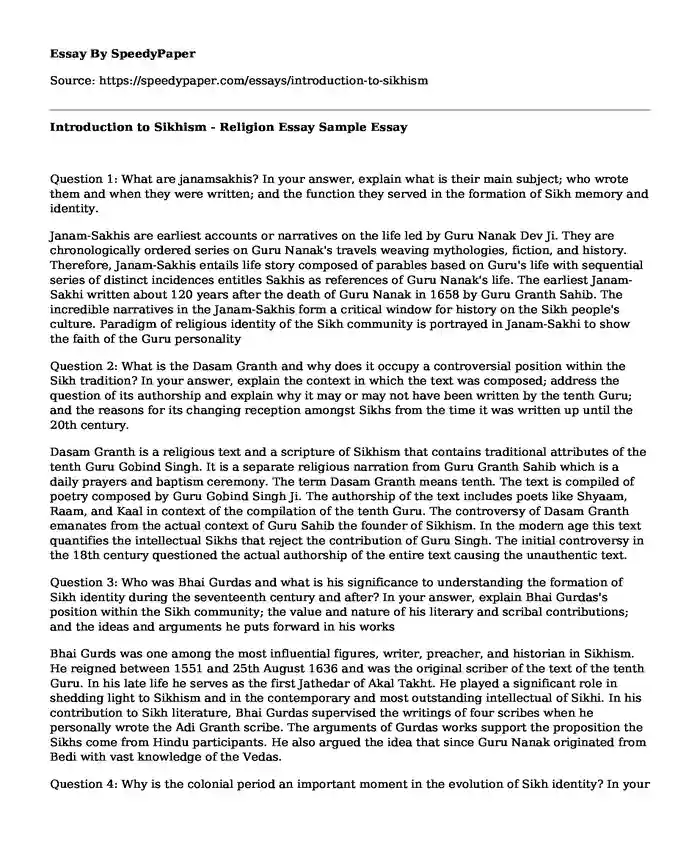Question 1: What are janamsakhis? In your answer, explain what is their main subject; who wrote them and when they were written; and the function they served in the formation of Sikh memory and identity.
Janam-Sakhis are earliest accounts or narratives on the life led by Guru Nanak Dev Ji. They are chronologically ordered series on Guru Nanak's travels weaving mythologies, fiction, and history. Therefore, Janam-Sakhis entails life story composed of parables based on Guru's life with sequential series of distinct incidences entitles Sakhis as references of Guru Nanak's life. The earliest Janam-Sakhi written about 120 years after the death of Guru Nanak in 1658 by Guru Granth Sahib. The incredible narratives in the Janam-Sakhis form a critical window for history on the Sikh people's culture. Paradigm of religious identity of the Sikh community is portrayed in Janam-Sakhi to show the faith of the Guru personality
Question 2: What is the Dasam Granth and why does it occupy a controversial position within the Sikh tradition? In your answer, explain the context in which the text was composed; address the question of its authorship and explain why it may or may not have been written by the tenth Guru; and the reasons for its changing reception amongst Sikhs from the time it was written up until the 20th century.
Dasam Granth is a religious text and a scripture of Sikhism that contains traditional attributes of the tenth Guru Gobind Singh. It is a separate religious narration from Guru Granth Sahib which is a daily prayers and baptism ceremony. The term Dasam Granth means tenth. The text is compiled of poetry composed by Guru Gobind Singh Ji. The authorship of the text includes poets like Shyaam, Raam, and Kaal in context of the compilation of the tenth Guru. The controversy of Dasam Granth emanates from the actual context of Guru Sahib the founder of Sikhism. In the modern age this text quantifies the intellectual Sikhs that reject the contribution of Guru Singh. The initial controversy in the 18th century questioned the actual authorship of the entire text causing the unauthentic text.
Question 3: Who was Bhai Gurdas and what is his significance to understanding the formation of Sikh identity during the seventeenth century and after? In your answer, explain Bhai Gurdas's position within the Sikh community; the value and nature of his literary and scribal contributions; and the ideas and arguments he puts forward in his works
Bhai Gurds was one among the most influential figures, writer, preacher, and historian in Sikhism. He reigned between 1551 and 25th August 1636 and was the original scriber of the text of the tenth Guru. In his late life he serves as the first Jathedar of Akal Takht. He played a significant role in shedding light to Sikhism and in the contemporary and most outstanding intellectual of Sikhi. In his contribution to Sikh literature, Bhai Gurdas supervised the writings of four scribes when he personally wrote the Adi Granth scribe. The arguments of Gurdas works support the proposition the Sikhs come from Hindu participants. He also argued the idea that since Guru Nanak originated from Bedi with vast knowledge of the Vedas.
Question 4: Why is the colonial period an important moment in the evolution of Sikh identity? In your answer explain how the emergence of new ideas, movements, institutions, and technologies helped inform what it meant to be a Sikh.
The Sikh identity receives misinterpretations that redefined its ideologies in the middle of the contemporary political dispositions of restricted Sikh organizations during and after the colonial era. The recognition of the identity-driven politics of colonialism contributed to the partition of Punjabi identity in 1947. Contemporary practices of ritualism within the shared identical topographies of Punjabi religious worship and traditions revolutionized to reinterpret Sikh history within the colonial movement. The capture of Punjab dispensed different pressure of Sikhism under colonialism focusing on religious identity reasonably to institutionalize Punjabi unity and change the appearance of the religion. Colonialism gained the credit of developing the regional identities that separated Punjabi religions. The Hindu identity conventionalized its substantial identity during the colonial period with nationalist movements and ideologies.
In reconciliation of the colonial domination with freedom and equality ideals of racial difference and hierarchy legitimized the capacity and eligibility of the identity revolutionized on the Sikhi community. In the colonies kingdoms, colonial heterogeneity managed racial classifications assigned to the indigenous communities in developmental and ideological movements. The requirements of colonial rule contributed to racial stereotypes of natives that facilitated sanctioned control of the regimes. The Sikhs practices, identities, and beliefs intermixed during the colonial era that consolidated Sikhism into a separate identity.
References
Guha, Ramachandra. (2007) India After Gandhi: The History of the World's Largest Democracy. New York: Harper Collins.
Singh, Khushwant. (2010). A History of the Sikhs: Volume 1: 1469-1839. 2nd ed. New Delhi: Oxford University Press.
Cite this page
Introduction to Sikhism - Religion Essay Sample. (2022, Apr 20). Retrieved from https://speedypaper.net/essays/introduction-to-sikhism
Request Removal
If you are the original author of this essay and no longer wish to have it published on the SpeedyPaper website, please click below to request its removal:
- Japanese Culture Essay Example
- Essay Example on Nissan Operations Management
- Pros and Cons of Fast Food - Essay Sample
- Essay Sample with Analysis of Business and Financial Performance of Burberry
- Essay Example on Gold and Oil in Africa
- Case Study Paper Sample on Acquisition of Genentech Company
- Essay Sample: Charles Dew's Apostles of Disunion Book Review
Popular categories





